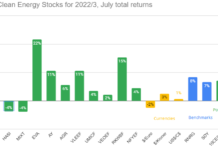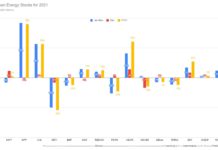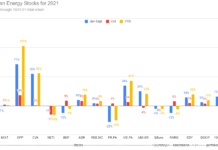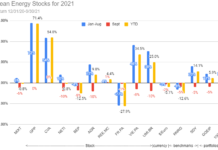Tom Konrad Ph.D., CFA
Earnings season began in earnest in February. My Ten Clean Energy Stocks model portfolio gave back a little of its large January gains because a mix of good and bad earnings mostly offset each other. One pick (Seaspan Preferred) gave back its large January gains. Neither the original gain nor the loss were driven by news. Instead, they seemed driven by investors changing expectations for global trade in an uncertain political environment.
For the year to March 17th, the portfolio and its income and growth subportfolios were all up 7.7%, 8.8%, and 5.4%. Clean energy stocks in general also did well, with my three respective benchmarks up 7.0%, 6.6%, and 8.0%. (I use the Yieldco ETF YLCO as a benchmark for the income stocks, the Clean Energy ETF PBW as a benchmark for the growth stocks, and an 80/20 blend of the two as a benchmark for the whole portfolio.) The Green Global Equity Income Portfolio (GGEIP), an income and green focused strategy I manage returned 6.7%.
The overall and growth portfolios all continue to out-perform their benchmarks, while PBW shot ahead of my two growth picks in February.
Detailed performance is shown in the chart below:

Stock discussion
Below I describe each of the stocks and groups of stocks in more detail.
Income Stocks
Pattern Energy Group (NASD:PEGI)
12/31/16 Price: $18.99. Annual Dividend: $1.63 (8.6%). Expected 2017 dividend: $1.64 to $1.67. Low Target: $18. High Target: $30.
2/28/17 Price: $20.79. YTD Dividend: $0. Annualized Dividend: $1.655. YTD Total Return: 9.5%
3/17/17 Price: $20.41 YTD Total Return: 7.5%
Wind-focused Yieldco Pattern Energy Group reported fourth quarter and full year 2016 results on March 1st, increasing the quarterly dividend 1.4%. I did not see anything to be concerned about in the earnings report, and I like the fact that Pattern, unlike many Yieldcos, has a focus on managing its assets efficiently rather than being content to be a passive owner of wind farms.
The stock declined slightly in response to the report, most likely because the firm’s accountants reported a material weakness in Pattern’s internal accounting controls. Management announced the discovery of this weakness in its third quarter earnings report, and they are working to correct it and continue to certify the accuracy of their financial statements.
Some investors will only invest in companies where the independent accountants have no reservations, and this report is the first one to be audited since the weakness was discovered. This is why I expect the stock fell slightly in response to an otherwise solid earnings announcement.
While not yet relevant to Yieldco shareholders, Pattern Energy’s parent, Pattern Development, completed the largest wind power project in British Columbia, the 184.6 MW Meikle Wind farm. Long-time readers will recognize Meikle as the same project that Finavera (a speculative extra pick in 2014) sold to Pattern Development that year. My track record picking such speculative stocks is poor (Finavera was no exception,) which is why I don’t do it any more, and stick to companies with long term solid cash flows like Pattern.
8point3 Energy Partners (NASD:CAFD)
12/31/16 Price: $12.98. Annual Dividend: $1.00 (7.7%). Expected 2017 dividend: $1.00 to $1.05. Low Target: $10. High Target: $20.
2/28/17 Price: $13.31. YTD Dividend: $0. Annualized Dividend: $1.00. YTD Total Return: 2.5%
3/17/17 Price: $12.70 YTD Total Return: -2.2%
Solar-only Yieldco 8point3 reported fourth quarter earnings on January 26th, and I covered them at the start of February. As I said at the time, the market is concerned about the Yieldco’s plans to refinance its interest-only company level debt with amortizing project level debt, and the impact this might have on its ability to grow its dividend.
I personally like the move, as it increases the safety of the stock, and I don’t require dividend growth to think that a company with a 7.8% yield is a decent value. Worries that 8point3 will not be able to refinance its debt and comparisons to bankrupt SunEdison are overblown. Unlike SunEdison, the overall level of 8point3’s debt ($673 million, per the Q4 Earnings Presentation) is easily manageable given its current annual EBITDA ($106 to $133 million expected for 2017.) The weighted average of 8point3’s power purchase agreements is over 20 years, and the company currently pays LIBOR+2% (less than 4%) interest on most of its debt. If we assume the company refinances with amortizing project level debt at a 5% interest rate and an average 20 year term, the annual payment (interest plus principal) will be about $50 million, compared to the current annual interest-only payment of $25 million.
The company’s outlook is for $91 to $101 million in 2017 cash available for distribution. Since this number likely includes some principal payments, we can expect that even if all of the Yieldco’s debt is immediately replaced with amortizing debt, there will be $80 million to $90 million in CAFD available to continue paying the current $1 annual dividend on the company’s 79.1 million class A and B shares.
As a worst-case scenario for shareholders, we should consider buying the stock at its current price, and receiving the current $1 dividend for 20 years, after which the stock becomes valueless. The internal rate of return for this cash flow stream is 4.8%: not particularly attractive, but something I’m quite comfortable with as a worst-case scenario.
I’ve been selling puts on the stock in order to add to my position if the stock price falls any further, or collect income if it does not.
Hannon Armstrong Sustainable Infrastructure (NYSE:HASI).
12/31/16 Price: $18.99. Annual Dividend: $1.32 (7.0%). Expected 2017 dividend: $1.34 to $1.36. Low Target: $15. High Target: $30.
2/28/17 Price: $19.79. YTD Dividend: $0. Annualized Dividend: $1.32. YTD Total Return: 4.2%
3/17/17 Price: $19.20&nbs
p; YTD Total Return: 1.1%
Real Estate Investment Trust and investment bank specializing in financing sustainable infrastructure Hannon Armstrong reported earnings after the close on February 22nd.
As I’ve previously discussed, the stock has been depressed recently because of worries about the possibility that the company might lose its REIT status. I have long believed that the company’s REIT status is not in danger, and, if it were, the impact on distributions would be minimal. In the earnings conference call, CEO Jeff Eckel addressed these concerns, saying that he did not expect the IRS to question HASI’s REIT status. He went on to say that if the company chose to convert to a taxable corporation, it could do so without any impact to its core earnings or distributions.
Shortly after the earnings announcement, the company conducted a secondary offering of common stock. The company typically makes several small secondary offerings each year shortly after earnings announcements. The new supply of stock temporarily depresses the stock price and provides an excellent buying opportunity for stock market investors. The current price of $19.20 represents such an opportunity.
NRG Yield, A shares (NYSE:NYLD/A)
12/31/16 Price: $15.36. Annual Dividend: $1.00 (6.5%). Expected 2017 dividend: $1.00 to $1.10. Low Target: $12. High Target: $25.
2/28/17 Price: $16.82. YTD Dividend: $0.26. Annualized Dividend: $1.04. YTD Total Return: 11.2%
3/17/17 Price: $16.70 YTD Total Return: 10.4%
Yieldco NRG Yield (NYLD and NYLD/A) announced 4th quarter earnings on February 28th and increased its quarterly dividend 4% to $0.26. The company is targeting continued annual per-share dividend growth of 15% through 2018. While such growth is likely for the next few quarters, I believe analysts’ dividend expectations will be scaled back for 2018 unless the stock price recovers and allows the company to raise new equity at more attractive prices.
One sour note was a $183 million non-cash impairment charge on certain wind farms acquired in 2015. $162 million of this was pure accounting fiction, and simply reflects that the price at which the assets were originally recorded on the books was more than NRG Yield had actually paid for them, but the other $21 million has to do with a change in NRG’s assumed long term power prices after the Power Purchase Agreements expire in 2017, 2022, and 2025. In other words, NRG Yield is admitting that, in hindsight, it overpaid for these three wind farms by at least $21 million, or about $0.20/share because of overly rosy long term assumptions about the value of the wind farms.
I believe many Yieldcos make overly rosy assumptions about the value of their assets after contract expiration, which is part of the reason why I have always preferred Yieldcos with high current dividends over ones promising high levels of long term growth. It’s easy to come up with assumptions that can justify very attractive long term growth rates, but that does not mean that those assumptions will be true. Dividends paid today are much harder to manufacture with accounting gimmickry.
Atlantica Yield, PLC (NASD:ABY)
12/31/16 Price: $19.35. Annual Dividend: $0.65 (3.4%). Expected 2017 dividend: $0.65 to $1.45. Low Target: $10. High Target: $30.
2/28/17 Price: $21.76. YTD Dividend: $0. Annualized Dividend: $1.00. YTD Total Return: 12.5%
3/17/17 Price: $21.67 YTD Total Return: 12.0%
Atlantica Yield announced its fourth quarter and full year results on February 27th. As expected following the receipt of forbearances from the Department on Energy on January 13th (and discussed here), the Yieldco raised its dividend 53% to $0.25. I expected a larger increase, to near $0.29 a share, but the firm still says that it will be able to increase the dividend to a sustainable rate of $1.60 when/if it is able to obtain forbearances on two projects in Mexico. Reduced dividends in 2016 gave the company the opportunity to reduce corporate debt by 4% in 2016 even while making acquisitions.
The company has a conservative capital structure of mostly amortizing project level debt, as well as a conservative 80% target payout ratio and no IDRs. Without a sponsor, the Yieldco has the freedom to use the retained cash flow to make targeted acquisitions from third parties. Most other Yieldcos are committed to only making acquisitions from their sponsors, reducing competition for attractive projects. All this means that Atlantica, now that the last effects of its former sponsor’s bankrupt are being dealt with, is better positioned for growth than most Yieldcos (with the possible exception of NEP.)
I’ve also been selling puts on ABY, and think the stock remains attractive at the current price.
NextEra Energy Partners (NYSE:NEP)
12/31/16 Price: $25.54. Annual Dividend: $1.36 (5.3%). Expected 2017 dividend: $1.38 to $1.50. Low Target: $20. High Target: $40.
2/28/17 Price: $30.79. YTD Dividend: $0.353. Annualized Dividend: $1.41. YTD Total Return: 21.9%
3/17/17 Price: $33.51 YTD Total Return: 32.7%
NextEra Energy Partners stock continues to advance after the release of its fourth quarter earnings in January, most likely due to analysts continuing to increase their price targets in response to the reduced IDR (see the last update for details.)
Other Income Stocks
Covanta Holding Corp. (NYSE:CVA)
12/31/16 Price: $15.60. Annual Dividend: $1.00 (6.4%). Expected 2017 dividend: $1.00 to $1.06. Low Target: $10. High Target: $30.
2/28/17 Price: $16.18. YTD Dividend: $0. Annualized Dividend: $1.00. YTD Total Return: 3.7%
3/17/17 Price: $15.65 YTD Total Return: 0.3%
Waste-to-energy developer and operator Covanta reported fourth quarter and annual results on February 16th. Earnings and revenues fell short of analysts’ expectations, although they were in line with company guidance. With the commencement of operations at the company’s Dublin facility, and higher metals recovery, the company is guiding for modest EBITDA growth but lower Free Cash Flow growth in 2017. The lower free cash flow for 2017 does not seem likely to be the beginning of a trend. Rather, it will be mostly driven by the reversal of a decline in working capital in 2016.
The company also declared its regular $0.25
dividend payable to shareholders of record on March 30th. It also issued $400 million of 5.875% notes due in 2025 to refinance debt with an interest rate of 7.25% and maturing in 2020. The net effect of this transaction should be to lower the company’s interest payments while extending the maturity of its outstanding debt.
The company is preparing to commence operations at its newest facility in Dublin, Ireland in March.
Seaspan Corporation, Series G Preferred (NYSE:SSW-PRG)
12/31/16 Price: $19.94. Annual Dividend: $2.05 (10.3%). Expected 2017 dividend: $2.05. Low Target: $18. High Target: $27.
2/28/17 Price: $20.56. YTD Dividend: $0.51. Annualized Dividend: $2.05. YTD Total Return: 5.4%
3/17/17 Price: $20.41 YTD Total Return: 4.7%
Leading independent charter owner of container ships reported earnings on March 1st, with a two-thirds cut to the common stock dividend. A dividend cut was expected, and this cut was at the high end of the expected range. This is good news for preferred shareholders, since the less money is paid to common share holders and is instead used to strengthen the company’s balance sheet and operations, the safer the (fixed) preferred dividends become.
Operationally, the company also delivered good news, with cost controls resulting in an 11.7% reduction in vessel ownership costs in the fourth quarter.
The common stock fell, as would be expected with such a large dividend cut, but the preferred shares have also declined slightly. I’ve added to my already large position in the preferred since the earnings announcement.
Growth Stocks
MiX Telematics Limited (NASD:MIXT).
12/31/16 Price: $6.19. Annual Dividend: $0.14 (2.3%). Expected 2017 dividend: $0.14 to $0.16. Low Target: $4. High Target: $15.
2/28/17 Price: $7.12. YTD Dividend: $0.037. Annualized Dividend: $0.14. YTD Total Return: 15.6%
3/17/17 Price: $6.90 YTD Total Return: 12.0%
Vehicle and fleet management software as a service provider MiX Telematics announced the results of its third fiscal quarter on February 2nd, delivering strong subscription revenue and increasing its guidance for its 2017 fiscal year, which ends on March 31st. I find it encouraging that the strong results came from strength in virtually every aspect of MiX’s business, rather than a couple of large sales. The growth and increase in subscription revenue is also allowing the company to increase its profitability because subscriptions produce higher margins than equipment sales, and spreading its fixed cost over a larger revenue base reduces per-unit overhead.
Investors initially reacted favorably to the strong quarter, sending the stock upward. It has since fallen back somewhat. If you do not already have a position in the stock, I see this as an excellent opportunity to take advantage of the company’s strengthening growth prospects before they are fully priced in by the market.
Aspen Aerogels (NYSE:ASPN)
12/31/16 Price: $4.13. Annual Dividend and expected 2017 dividend: None. Low Target: $3. High Target: $10.
2/28/17 Price: $4.13. YTD Total Return: 0%
3/17/17 Price: $4.08 YTD Total Return: -1.2%
Aspen Aerogels fourth quarter earnings were worse than expected, with the important subsea segment reducing revenue even below the company’s already bearish guidance. The company has made progress expanding the customer base, but this is a slow process and the company does not expect any large sales to single customers like it has had in the past. While the growing base of smaller customers should lead to better long term income stability and growth, they are currently only filling the gap left by the disappearance of larger one-off sales.
The company’s long term prospects remain encouraging, but investors should be prepared for a couple more quarters for disappointing growth. I have sold my position in anticipation of short term stock weakness which should allow me to repurchase the stock at a lower price, most likely after first or second quarter earnings announcements.
Final Thoughts
Broad stock market valuations remain high despite an unpredictable political climate. I think that investors should continue to position themselves companies with long term contracted cash flows that are unlikely to be significantly affected by possible economic disruptions. Given the anti-renewable energy rhetoric coming from Washington DC, Clean Energy Yieldcos like PEGI, ABY, HASI, and CAFD seem to have the perfect mix of low valuations combined with very safe revenue streams. Worries about global trade also seem to be causing investors to undervalue the security of the dividends on Seaspan’s preferred shares.
I’ve been increasingly focusing my investments on these names, while reducing exposure to the market in general. These tactics are unlikely to deliver the 20-30% portfolio returns I managed last year, but right now I think investors should be wise to focus on protecting themselves from potential market disruptions.
Disclosure: Long HASI, MIXT, PEGI, NYLD/A, CAFD, CVA, ABY, NEP, SSW-PRG, ASPN, GLBL, TERP. Long puts on SSW (an effective short position held as a hedge on SSW-PRG.)
DISCLAIMER: Past performance is not a guarantee or a reliable indicator of future results. This article contains the current opinions of the author and such opinions are subject to change without notice. This article has been distributed for informational purposes only. Forecasts, estimates, and certain information contained herein should not be considered as investment advice or a recommendation of any particular security, strategy or investment product. Information contained herein has been obtained from sources believed to be reliable, but not guaranteed.







